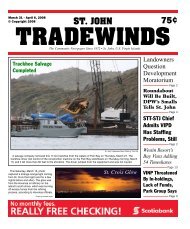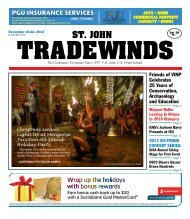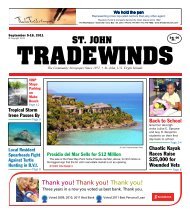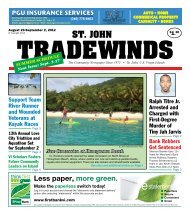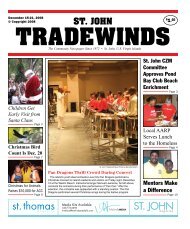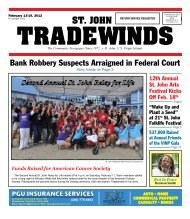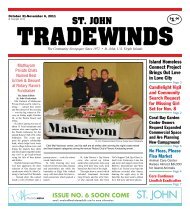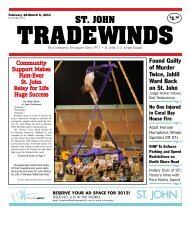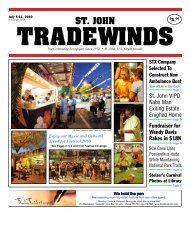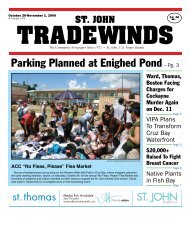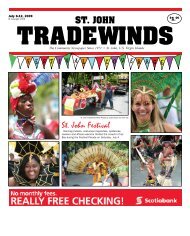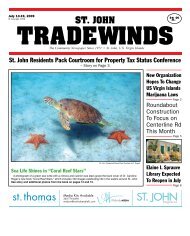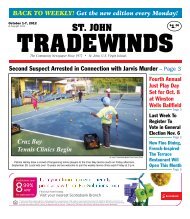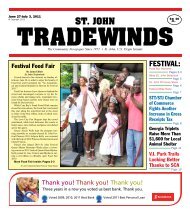TW_06.14.10_Edition.pdf - St. John Tradewinds News
TW_06.14.10_Edition.pdf - St. John Tradewinds News
TW_06.14.10_Edition.pdf - St. John Tradewinds News
Create successful ePaper yourself
Turn your PDF publications into a flip-book with our unique Google optimized e-Paper software.
<strong>St</strong>. <strong>John</strong> Bays Ideal for Shark Nurseries, Important<br />
To Sustaining Shark Populations, NOAA Discovers<br />
By Andrea Milam<br />
<strong>St</strong>. <strong>John</strong> <strong>Tradewinds</strong><br />
The shallow bays found around<br />
<strong>St</strong>. <strong>John</strong> provide the perfect place<br />
for several species of sharks to<br />
avoid predation until they are big<br />
enough to enter deeper waters,<br />
making the island integral to sustaining<br />
shark species.<br />
The National Oceanic and Atmospheric<br />
Administration, which<br />
has been conducting research<br />
around the territory to learn more<br />
about the shark populations utilizing<br />
local bays, presented its findings<br />
on Thursday evening, June<br />
10, at Maho Bay Camps.<br />
Shallow bays are ideal places<br />
for shark nurseries, as sharks offer<br />
no postnatal care to their young.<br />
The mother takes off right after<br />
birth, leaving young sharks to<br />
fend for themselves.<br />
“Shark nurseries occur in shallow<br />
near-shore habitats, and they’ll<br />
spend a lot of time there for the<br />
first couple years of their lives,”<br />
said Bryan DeAngelis of NOAA<br />
at the June 10 presentation. “People<br />
are beginning to hypothesize<br />
that shark populations are limited<br />
highly by just how much available<br />
habitat there is.”<br />
Most predation of baby sharks<br />
is done by adult sharks, making<br />
shallow waters — where larger<br />
sharks can’t swim — the best place<br />
for sharks to spend their first few<br />
years. There’s also an abundance<br />
of food in shallow areas, which<br />
is important to young sharks who<br />
need a lot of energy, DeAngelis<br />
explained.<br />
“Despite all other pressures<br />
such as over fishing and offshore<br />
harvesting of fins, if there’s not<br />
enough habitat for shark nurseries,<br />
the population may not be able to<br />
sustain itself,” he said.<br />
Shark regulation in the Virgin<br />
Islands falls under the federal Fishery<br />
Management Plan for Sharks<br />
of the Atlantic Ocean; however,<br />
federal management alone may<br />
not be enough to sustain the health<br />
of local shark populations. When<br />
DeAngelis and NOAA began their<br />
quest, it was discovered that collection<br />
of local data was very difficult<br />
and sufficient enforcement<br />
was lacking.<br />
“Nobody had ever done a survey<br />
that said who was here and<br />
what type of habitat they were using,”<br />
said DeAngelis. “Before we<br />
could concentrate on learning more<br />
about nursery areas, we needed to<br />
document who was here.”<br />
The NOAA team documented<br />
blacktip, blacknose, Caribbean<br />
reef, Caribbean sharpnose, hammerhead,<br />
tiger, lemon and nurse<br />
sharks around the Virgin Islands.<br />
DeAngelis and his coworkers<br />
utilized acoustic hydrophones to<br />
track sharks in shallow bay nurseries.<br />
Sharks are captured and in just<br />
a few minutes, a transmitter is<br />
surgically implanted inside the<br />
fish before it is released into the<br />
ocean.<br />
“The transmitters emit an<br />
acoustic ping which is picked up<br />
by acoustic hydrophone receivers<br />
at the bottom of the ocean,” said<br />
DeAngelis. “The receiver stores<br />
the date and time of the ping, and<br />
you can start to get an image of<br />
what habitats the sharks are using.<br />
You can really start to expand<br />
your knowledge of these guys and<br />
how they’re using the area.”<br />
NOAA must now begin to<br />
<strong>St</strong>. <strong>John</strong> <strong>Tradewinds</strong> <strong>News</strong> Photo by Bryan DeAngelis<br />
<strong>St</strong>udent assistant Ian Bouyoucos examines a blacktip<br />
shark as part of the National Oceanic and Atmospheric<br />
Administration’s Virgin Islands shark research project.<br />
analyze the thousands of pieces<br />
of data collected by the receivers.<br />
DeAngelis hopes to answer<br />
questions including how long are<br />
sharks staying in the bays, how<br />
strong is the site fidelity, and what<br />
are the emigration and mortality<br />
rates. He also hopes to investigate<br />
connectivity of populations in different<br />
bays.<br />
DNA is also being collected<br />
from sharks in the hopes that information<br />
will eventually be used<br />
to further determine relationships<br />
between different nurseries.<br />
While <strong>St</strong>. <strong>John</strong> bays do provide<br />
ideal habitats for shark nurseries,<br />
people should not be concerned<br />
about being attacked while in the<br />
water, DeAngelis explained.<br />
“We work all day just to find a<br />
couple of sharks,” he said. “The<br />
ones we do find are really, really<br />
small babies and they’re really, really<br />
scared of people. Take it from<br />
me, a very frustrated person who<br />
will watch a shark swim around a<br />
piece of bait for hours before it decides<br />
it wants to take it: there are<br />
no sharks in these waters that we<br />
need to be afraid of.”<br />
<strong>St</strong>. <strong>John</strong> <strong>Tradewinds</strong>, June 14-20, 2010 5



